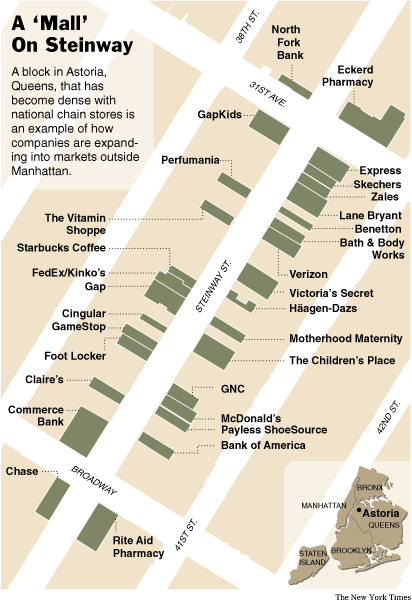Franchises sucking the local flavor out of L.A.
DC1974 sends us this article from the Los Angeles Times. I think this phenomenon is widespread, but it has to do more with high value areas. There are many areas of Los Angeles or Manhattan or Brooklyn or Queens, that is not experiencing the level of chaining up that the article addresses.
Still, it is a problem. The places with the strongest demographics get increasing demand and increasing demand from chains, which crowds out the independents.

A 'Mall' on Steinway Street, from the New York Times.
I haven't had a chance to upload any of my photos of LA from a couple weeks ago, including some (middling) photos of The Grove, Rick Caruso's breakthrough money printing machine located next to the more traditional Los Angeles Farmers Market in the Mid-Wilshire/Museum Mile District of LA.
It was jammed full of people, at mid-day on a Friday, just jammed. And it comes with a gargantuan parking garage immediately adjacent--and a fabulously merchandised escalator-elevator area (selling cars and other things) as people move their way up and down the garage, to and from the shopping center.
The Grove was one of the first "lifestyle centers," an extension I suppose of the concept first laid out to great success by John Jerde in the Universal CityWalk.
The current issue of Chain Store Age (a trade magazine for the retail industry) has a 50+ page special section on lifestyle centers and harvesting successful principles from the traditional commercial districts for developer produced projects.
These days, Baltimore's Cordish Companies are becoming one of the more in-demand producers of similar kinds of retail-tainment centers. See "Cordish to run casino in Ind.," from the Baltimore Sun.
To deal with this, zoning and use regulations needs to be more carefully drawn to include:
- limits on the total amount of formula retail allowed in traditional commercial districts
- neighborhood serving retail requirements
- space for civic functions and uses
- requirements and support systems for independent retail within such places
But more importantly, broader restrictions that force investment where infrastructure and space already exist, rather than in totally new places.
I have to say that the Los Angeles Farmers Market has met demands for new and broader retail in part by opening up some adjacent space (just before The Grove) to new retailers such as CostPlus World Market. This strengthens the overall offer, and helps the Market remain competitive in the face of other destinations and districts in the area. But it helps to be located next to The Grove, which runs its faux trolley into the LA Farmers Market complex, so the two shopping areas are connected.
Speaking of parking, the cost of short term parking 0-3 hours, is very low, I think $3 for 3 hours. But I seem to recall the price increases significantly after 3 hours.
Labels: formula retail, retail, urban revitalization, zoning



0 Comments:
Post a Comment
<< Home